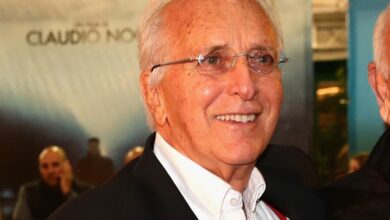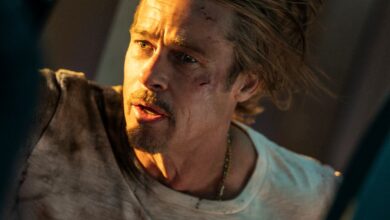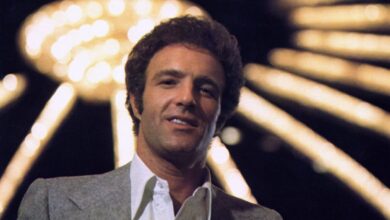‘Scorsese threw a desk over and ran out the room’: The tortured making of Gangs of New York, 20 years on

In June 1977, a two-page ad was published in the Hollywood trade magazine, Daily Variety. The ad announced a film that was about to go into production: Gangs of New York, from the hot thirtysomething director of Taxi Driver, Martin Scorsese. Based on a cult favourite book by Herbert Asbury, the film would be an epic tale about Five Points slum in 19th-century New York and the gangs who terrorised its streets. It would ultimately take 25 years to put Scorsese’s grand vision on the big screen. The film – starring Leonardo DiCaprio, Daniel Day-Lewis, and Cameron Diaz – was finally released on 20 December 2002, after decades of delays, a vast reconstruction of Lower Manhattan in Rome, and a series of spats between Scorsese and his since disgraced producer, Harvey Weinstein.
Now, 20 years since its release, Gangs of New York is a curious entry in Scorsese’s body of work. It’s something of a spiritual prequel to his contemporary gangster films, but oddly of-its-time, too – even Scorsese succumbed to post-millennium stylings.
For Martin Scorsese, Gangs of New York was personal. Growing up in Little Italy, he was fascinated by stories of gangs in his neighbourhood – in particular, a clash between American-born Protestants and Irish Catholic immigrants, which had taken place outside Scorsese’s local church in 1844. There were also clues dotted around – from weathered headstones to archaic cobbled streets – that gave him an inkling of what the neighbourhood might have been like 100 or more years earlier.
“I gradually realised that the Italian-Americans weren’t the first ones there, that other people had been there before us,” Scorsese told the Smithsonian in December 2002. “As I began to understand this, it fascinated me. I kept wondering, how did New York look? What were the people like? How did they walk, eat, work, dress?”
In 1970, Scorsese chanced upon the book, The Gangs of New York by Herbert Asbury. First published in 1927, the book detailed the gangs of Lower Manhattan – particularly in the Five Points, an area that encompassed an intersection of roads (where Chinatown now stands) named for its five corners. The Five Points – notorious for its crime, filth, and disease – was home to many immigrants, including Irish, who at times poured into New York at a rate of 15,000 per week. The amusingly named gangs were made up of Irish sluggers, or native-born, anti-immigrant Americans – the Dead Rabbits, the Plug Uglies, the True Blue Americans, the Shirt Tails, the Roach Guards and the Bowery Boys. Corrupt politicians used the gangs for their muscle and influence. The gangs helped fix polls or influence voting. According to Asbury’s book, gangs would feud and fight for days on end.
There was more at stake than a good beating. “The country was up for grabs, and New York was a powder keg,” Scorsese told the Smithsonian. “This was the America not of the West with its wide-open spaces, but of claustrophobia, where everyone was crushed together.” He added: “It was chaos, tribal chaos. Gradually, there was a street by street, block by block, working out of democracy as people learned somehow to live together. If democracy didn’t happen in New York, it wasn’t going to happen anywhere.”
Scorsese optioned The Gangs of New York and his friend, Jay Cocks – the critic-turned-screenwriter – finished the first draft of the script in 1978. The story, which went through many drafts and several additional writers, begins with a showdown between the Irish gang, the Dead Rabbits, led by Priest Vallon (Liam Neeson), and the anti-immigration Natives, led by the meat cleaver-wielding Bill “The Butcher” Cutting (Daniel Day-Lewis). Bill kills Vallon, as witnessed by Vallon’s young son, Amsterdam (who grows up to become Leonardo DiCaprio). Amsterdam returns to the Five Points years later to take revenge. He’s almost sucked into Bill the Butcher’s cult of personality, forming a strange father-son bond, before Amsterdam resurrects the Dead Rabbits and fights to the death with Bill.
Mixing historical fact and fiction, it’s set against the backdrop of the 1863 Draft Riots – a deadly, days-long uprising, looting, and lynching, which was sparked by the Civil War Draft. Bill the Butcher was based on Bill Poole, leader of the Bowery Boys gang and a member of the nativist Know Nothings political party.
Scorsese’s vision was simply too expensive. To bring the story to life, Scorsese needed to recreate – actually build – a significant portion of 1860s New York. “By 1980 the time when directors were given large sums of money to make personal movies had ended,” wrote Scorsese in a book about the film. He held onto the project though.
In the early Nineties, Gangs of New York went into development at Universal. Robert De Niro, then Scorsese’s go-to man, was attached at one point, in line to play Bill the Butcher. The project then went to Disney, but Disney started to balk at the violence. (Even Scorsese – the director who put a mobster’s head in a vice – would struggle with that aspect. “The violence is tricky,” he told The New Yorker, “but that’s the way those characters behaved. I have to figure out how to shoot it”.)
It was also a few years since Scorsese had scored a box office hit. In 1995, Casino – an undisputed Scorsese masterpiece – was a disappointment in the US. Kundun and Bringing Out the Dead were straight-up box office duds in 1997 and 1999, respectively.
But with a $65m deal secured for international distribution, Miramax – a Disney subsidiary, then run by Harvey and Bob Weinstein – took control. In the book Down and Dirty Pictures, American critic Peter Biskind described how Scorsese was “a trophy director [and] Oscar bait” for Harvey. This was the time when the Weinsteins were establishing a grip over awards season. “Harvey was a kingmaker of actors and directors,” says Michael Hausman, executive producer on Gangs of New York. “In those days nobody wanted to cross Harvey – or his brother.”
Leonardo DiCaprio had first heard about The Gangs of New York when he was just 16 (about the age he made Critters 3). At 17, he changed agencies just to be in potentially closer contact with Scorsese. At the time, not everyone saw DiCaprio as an acting heavyweight. Following Titanic and The Beach there remained an air of heartthrob about his rep. That Scorsese has cast him (DiCaprio starred in Steven Spielberg’s Catch Me If You Can the same year) put him on a new level. In the 20 years since, DiCaprio has been Scorsese’s most significant onscreen collaborator, starring in five more of his films.
With De Niro long gone, Daniel Day-Lewis took the role of Bill the Butcher. Day-Lewis was typically intense: he shadowed a real butcher – “You never know what will help,” he once joked – and mastered the art of swinging a meat cleaver around. Day-Lewis stayed in character and “relished Bill’s companionship”. “I never met Daniel Day-Lewis on the movie,” says Hausman. “It was always Bill the Butcher. It was confusing! I’d knock on his door and have to say, ‘Bill, I’ve got a question for you…’ I saw him years later. I said, ‘It’s been five years, can I call you Daniel now?’”
Liam Neeson – who played Priest Vallon, slaughtered by Bill in the opening battle – played a game of one-upmanship with Day-Lewis. Neeson found out that Day-Lewis went to the gym at 5.30am, so he started getting there at 4.30am – so as Day-Lewis was coming in, Neeson was leaving.
Daniel Day-Lewis (centre) leads the Natives in ‘Gangs of New York’
Day-Lewis saw Bill the Butcher as “a hooligan dandy”. Indeed, with his stovepipe hat, swish tailoring, and American eagle glass eye, Bill is a moustache-twirling cartoon villain. But one sketched upon the film’s melting pot of themes: political fury, corruption, patriotism, pride, racial tensions, history, the making of democracy.
He wasn’t the only one taking it intensely. Screenwriter Hossein Amini, who worked on two drafts, recalled two days of 12-hour meetings with DiCaprio, just talking about character and dialogue. DiCaprio said his prep also included “weight training, knife throwing, and various fighting methods from the period”.
There was lots of historical research done – though the film isn’t strictly factual – and the production was designed to be real and period accurate. As well as Herbert Asbury’s book, they relied on Lucy Sante’s Low Life, about old school Manhattan, and the Rogue’s Lexicon, from 1859, for period-specific slang. For the myriad of accents, the actors turned to dialect coach Tim Monich. The big challenge was creating the accent for working class native New Yorkers in the 1860s, for which there was very little historic evidence to emulate. Listening to a recording of poet Walt Whitman, Monich decided it wouldn’t sound all that different to a 20th-century Brooklyn cab driver.
Watched now, Gangs of New York boasts an impressive cast. Alongside Day-Lewis, DiCaprio, Diaz, and Neeson are Jim Broadbent, John C Reilly, Brendan Gleeson, Stephen Graham, and Henry Thomas – then best known as Elliot from ET. The real star, however, was 1860s New York, including the Five Points, which was recreated at the Cinecitta Studio in Rome, Italy. Production designer Dante Ferretti constructed more than a mile of buildings – essentially several blocks of Lower Manhattan. The Five Points got very real. “After we’d had a couple of storms, which had etched their own character into the streets, the cobblestones turned to muck,” says Day-Lewis. “I just love that place. I loved being in it. It was my home.”
They had written so many versions [of the script]! … Sometimes [the cinematographer] had set something up and Marty would say, ‘No, we’re doing it from another direction!’
Cameron Diaz and Daniel Day-Lewis in ‘Gangs of New York’





